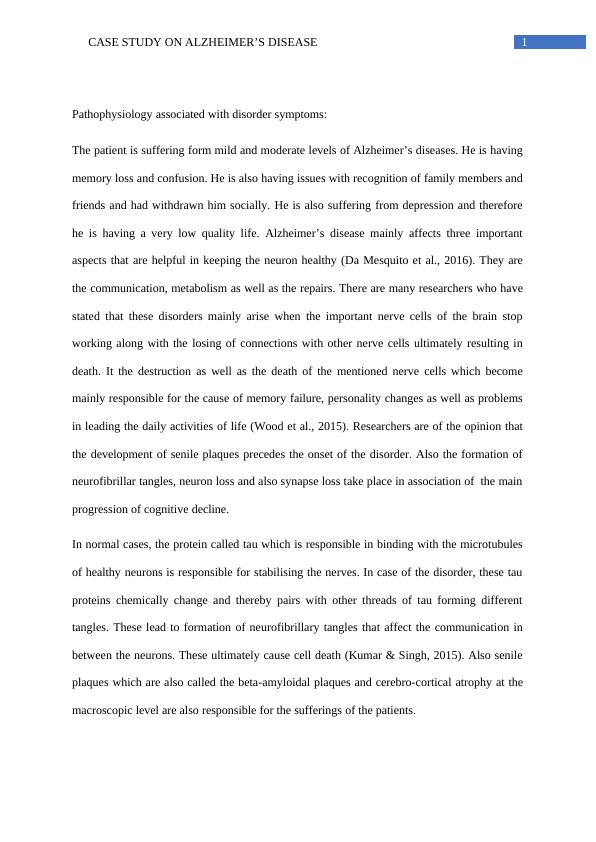Pathophysiology associated with disorder symptoms: An Alzheimer's patient
Added on 2020-03-07
7 Pages1650 Words281 Views
Running head: CASE STUDY ON ALZHEIMER’S DISEASECASE STUDY ON ALZHEIMER’S DISEASEName of the student:Name of the university:Author note:

1CASE STUDY ON ALZHEIMER’S DISEASEPathophysiology associated with disorder symptoms:The patient is suffering form mild and moderate levels of Alzheimer’s diseases. He is havingmemory loss and confusion. He is also having issues with recognition of family members andfriends and had withdrawn him socially. He is also suffering from depression and thereforehe is having a very low quality life. Alzheimer’s disease mainly affects three importantaspects that are helpful in keeping the neuron healthy (Da Mesquito et al., 2016). They arethe communication, metabolism as well as the repairs. There are many researchers who havestated that these disorders mainly arise when the important nerve cells of the brain stopworking along with the losing of connections with other nerve cells ultimately resulting indeath. It the destruction as well as the death of the mentioned nerve cells which becomemainly responsible for the cause of memory failure, personality changes as well as problemsin leading the daily activities of life (Wood et al., 2015). Researchers are of the opinion thatthe development of senile plaques precedes the onset of the disorder. Also the formation ofneurofibrillar tangles, neuron loss and also synapse loss take place in association of the mainprogression of cognitive decline.In normal cases, the protein called tau which is responsible in binding with the microtubulesof healthy neurons is responsible for stabilising the nerves. In case of the disorder, these tauproteins chemically change and thereby pairs with other threads of tau forming differenttangles. These lead to formation of neurofibrillary tangles that affect the communication inbetween the neurons. These ultimately cause cell death (Kumar & Singh, 2015). Also senileplaques which are also called the beta-amyloidal plaques and cerebro-cortical atrophy at themacroscopic level are also responsible for the sufferings of the patients.

2CASE STUDY ON ALZHEIMER’S DISEASEIn case of Alzheimer’s patients plaques are mainly developed in the hippocampus which is astructure deep in the brain. This part is mainly responsible in encoding memories. Plaquesalso appear in other areas of cerebral cortex which mainly help an individual in thinking andalso in decision making. Therefore it is seen in the case study, that the individual is sufferingfrom memory loss symptoms largely. Tangles are also insoluble twisted fibres that build upinside the nerve cells that hamper the memory system of patients.A large number of studies have suggested that development of depression and also socialwithdrawal increases the chance of getting affected by dementia and Alzheimer’s diseases bymany folds. Investigations which have been done by researchers show that depression isintricately linked with Alzheimer’s, the exact biological background is still under controversybut evidences available suggest that depressed people always produce hormone cortisol inhigh levels. This has negative effect on the part of the brain responsible for new learning aswell as short term memory which is the hippocampus (Abolhassani et al., 2017). People likethe patient in the case study who are depressed have higher level of cortisol that mainly ishormone related with stress response and also has a smaller hippocampus. Many otherssuggest that depression causes chronic inflammatory changes which dispose depressedpatients to neurodegenerative disorders like Alzheimer’s disorder. As his own property wasgetting g divides, it might have lead him to depression and social withdrawal which h hadcaused him to suffer form Alzheimer’s as well.Pharmacologic management:The professional should keep in mind that Alzheimer’s diseases is a progressive diseaseswhere the patient will continue to decline in function whether they are rerated or are keptwithout treatment. Therefore, pharmacologic management would be such that it would helpto preserve and facilitate the remaining function of the synapse and allowing a higher level of

End of preview
Want to access all the pages? Upload your documents or become a member.
Related Documents
Alzheimer’s Disease – A Case Studylg...
|7
|1869
|197
How does long term memory and short term memory differ in people with Alzheimer?lg...
|8
|2228
|45
Study on Alzheimer’s Diseaselg...
|10
|3369
|272
Alzheimer’s Disease: Symptoms, Causes, and Treatmentslg...
|7
|2010
|405
Care for Older People - Case Studylg...
|11
|3312
|26
NUR104 Assessment Task 3: Case Study Analysislg...
|7
|3269
|273
